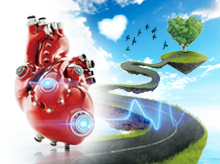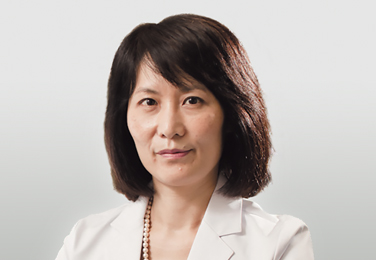

Specialist in Cardiology
Matching Heartbeat with the Nature
Advancement in Device Therapy for Arrhythmias
Atrial fibrillation (AF) is the most common cardiac arrhythmia affecting 1-4% of adults worldwide, whereas the prevalence of AF increases with age that more than 13% of adults aged 80 or above are affected1. Thus, the epidemic of AF has been recognised as a growing global health problem. In Hong Kong, approximately 1% of general population is affected by arrhythmia2, especially among elderly. Former analysis on local inpatient discharges and deaths due to AF suggested that 74.3% of episodes occurred in elderly aged 65 and above3. Currently, there is a wide range of treatments for arrhythmia, depending on the diagnosis of the disorder. Nonetheless, device therapy with implantable devices, such as pacemakers and defibrillators, is frequently employed in managing rhythm disorders. In a recent sharing, Dr. Kathy Lee shared her expertise in managing cardiac arrhythmia and opinions on future development of device therapy for the disease.
A Brief History of Device Therapy in Cardiology
The history of device therapy applying electrical energy to the body can be traced back to the 18th century. In 1775, a Danish physicist, Nickolev Abildgaard, conducted the first studies investigating the effects of electrical energy when applied to the body using a hen model. When electrodes were placed on the sides of a hen’s head and applied an electric discharge, the hen fell dead. However, when the electrodes were applied over the hen’s chest, the hen staggered onto its feet and walked away4. A stimulation device in 1788 is shown in Figure 1.

Figure 1. Stimulation device in 17884
The first integrated theory of cardiac pacing was developed by a British physician, John Alexander MacWilliam, who published a series of articles on cardiac electrophysiology in mammals between 1887 and 1899. Of importantly, he proved the possibility to evoke cardiac contractions by electrical stimulation applied directly to the heart5.
The translation from pacing theory into practical therapy occurred in the 1920s and 30s by the works of Mark Lidwell and Albert Hyman. Lidwell saved the life of a child born in cardiac arrest using intermittent electrical stimulation of the heart in 1928, whereas Hyman developed an electro-mechanical instrument which was powered by a spring-wound, hand-cranked motor. Hyman coined the instrument as “artificial pacemaker” in 1932 (Figure 2)4.

Figure 2. Hyman’s artificial pacemaker in 19324
With the improved electrical technology and material sciences, as well as better understanding on heart diseases especially arrhythmias, battery-powered portable pacemaker was developed by Earl Bakken in 19575. Nonetheless, the first implantable internal pacemaker, a totally implantable system incorporating a silicone transistor and rechargeable nickel-cadmium batteries, was developed by Ake Senning and Rune Elmqvist in 19586.
With further advances in sensor technology, biocompatible materials, miniaturisation, computerised instrumentation and surgical techniques have dramatically improved the safety profile and cost-effectiveness of device therapy in recent decades, which, in turns, significantly reinforced the survival and quality of life of patients with arrhythmia.
Correcting the Wrong Beats
Dr. Lee outlined that there are 3 types of cardiac implantable electronic device commonly used: (1) Pacemakers for treating bradycardia, (2) Defibrillators which stabilise fast and dangerous heartbeats, whereas some defibrillators also incorporate with protocol for bradycardia, and (3) Implantable recording devices for long-term monitoring of cardiac functions. However, the recording device is not for therapeutic purposes and is less common.
The clinical benefits of device therapy in managing rhythm disorders and related complications have been well reported. For instance, a meta-analysis by Vakil et al (2016) showed that treatment with implantable cardioverter-defibrillators (ICD) was associated with a 39% relative risk reduction in all-cause mortality as compared to non-ICD group (relative risk [RR]: 0.61; p<0.01, Figure 3) in the pooled group of patients with left ventricular assist devices (n=937)7. Besides, Weiss et al (2013) demonstrated in a clinical trial involving 314 patients with a standard indication for an ICD that the 180-day system complication-free rate achieved by subcutaneous ICD was 99%8. These findings thus indicate the improved health outcomes and safety of an implanted ICD system in patients with ventricular arrhythmia.

Figure 3. Reduced all-cause mortality by ICD therapy7. CI: confidence interval; RR: relative risk
Clinically, device therapies are employed for arrhythmic conditions which cannot be controlled with medications. Dr. Lee addressed that there is no suitable medication for bradycardia and hence device therapy would be prescribed. “Although there are medications for tachycardia, device therapy is still needed when the efficacy of medication is suboptimal or the patient is intolerant. Notably, there are established evidences on the efficacies of defibrillator in critical tachycardia, so device therapy is preferred in these cases,” she added.
Dr. Lee described that, in patients with heart failure, there are conduction abnormalities leading to impaired systolic function. Cardiac resynchronisation therapy (CRT), which involves implantation of a device at the left ventricle, would be employed to generate electrical stimuli and hence to enhance cardiac contractility. This device therapy is prescribed on top of medications and is proven effective in terms of reducing mortality when the ejection fraction is low.
Handling the Perceived Stressors
The development of implantable cardiac devices represents a modern medical achievement with substantial life-saving benefits for patients at risk for potentially life-threatening arrhythmias. Nonetheless, challenges for this technology have emerged in various aspects. In terms of patients’ acceptance, previous report suggested that 13-38% of ICD patients were affected by anxiety, whereas depression occurs in 24-46% of ICD patients9. In Hong Kong, based on Dr. Lee’s observation, mental distress occurs in around 10-20% of ICD patients. However, Dr. Lee emphasised that the impact of other implanted devices, such as pacemakers, on daily life is minimal and mental distress is uncommon with these devices.
In order to minimise the risk of potential stress, Dr. Lee advised frontline physicians to inform the patients about possible treatment-related adverse events, such as pain. Also, it is crucial to recognise the importance of the device therapy prescribed and the consequences if cardiac disorder is left untreated, including sudden death. She suggested that experience sharing from patients treated by device therapy would relieve potential mental distress for patients.
Besides mental distress, infections associated with cardiac device implantation have been a clinical concern that the reported incidence of cardiac implanted device infections varies from 0.13% to 19.9%10. Dr. Lee commented that device therapy-related infection is not common in Hong Kong, accounting for only about 2% of cases. She reminded that the risk is associated with both patient and procedural factors. Particularly, higher risk of infection occurs during device replacement though the procedure is generally simpler with shorter duration. Moreover, patients with comorbidities such as diabetes or lower immunity are at higher risk of infection.
The Improved Durability and Compatibility
The advances in battery and capacitor technology allow the dramatic reduction in physical size of implanted cardiac devices, with optimised longevity and more reliable decay curves. With the advent of compact implanted devices, minimally invasive surgery has gained popularity and this helps overcome possible postoperative complications such as major incisions and poor outcomes due to infections, right heart failure, and bleeding11.
In spite of the improved surgical technique, the durability of battery and the implanted device is a major factor determining the need of surgery for device replacement. Dr. Lee mentioned that the durability of device varies based on the functions of the device and the amount of stimulation required. For instance, she described the rate responsive pacemakers (RRP) which are equipped with extra sensors to detect activities of patients more accurately, and hence the stimulating protocol is more accurately adjusted to produce an appropriate heart rate meeting the physiological needs. These features would increase the demand on battery power. “On average, for bradycardia pacing, the device can function for more than 10 years, whereas defibrillators consume more energy and can normally work for about 8 to 10 years,” said Dr. Lee.
Magnetic resonance imaging (MRI) is the gold standard of diagnostic tool for soft tissue imaging in many specialties. In response to the inquiry on safety concern of device therapy in MRI, Dr. Lee addressed that, currently, most implantable devices are compatible with MRI. However, she reminded that, in the first 6 weeks after implantation, the leads of the device may not be securely fixed and MRI is not recommended. “Former report suggested that, even for older models of device, the risk is not that high with close monitoring during MRI process. Nonetheless, MRI-compatible models are preferred,” noted Dr. Lee.
The Non-stop Evolution of Device Therapy for Cardiac Arrhythmias
There have been dramatic advances in the technology of device therapy in cardiology since the first pacemaker was implanted in 1958. In order to address the increasing demand on battery power for implanted devices, there are opinions advocating the use of renewable energy in implanted devices. For instance, Roberts et al (2008) demonstrated the feasibility of energy harvesting of cardiac motion using a catheter-mounted device (CMD) in a pig model. The CMD could be incorporated into a pacemaker or ICD lead and assist powering. The study reported that the CMD produced 17% of the energy required to power a conventional pacemaker12.
Dr. Lee addressed that the leads of the implanted device would possibly induce noises, resulting in stimuli generation and hence triggering inappropriate shocks. Further, there is also an infection risk associated with the leads. The lead is implanted in the heart and thus lead-associated infections would result in serious complications. Thus, she emphasised that wireless technology is one of the main directions for implanted device development. Thanks to the miniaturisation of implanted devices, some designs of device are now available allowing implantation of the entire device subcutaneously so that no lead is needed.
Dr. Lee highlighted the importance of development in data acquisition and transfer with implanted device. Based on the physiological and pathological data collected with implanted devices, physicians can monitor the real-time cardiac conditions of patients. Hence, the technology would replace regular follow-up and allow early detection of hardware failure, arrhythmias and heart failure decompensation. This is particularly useful for patients who have difficulty in visiting the clinics. Nonetheless, Dr. Lee agreed that there could be concerns on security for unauthorised access of the implanted devices which possibly endangers the patient’s life. Thus, further works ensuring cybersecurity in this aspect is particularly important.
Undoubtedly, implanted cardiac device therapy is a highly efficient, non-pharmacological treatment option that delivers rapid pacing stimuli reducing mortality associated with cardiac arrhythmias. “Improvements in both surgical procedures and hardware technologies of device therapy, especially wireless technology, would enhance patients’ acceptance on the treatment,” concluded Dr. Lee. Indeed, further optimisation on the therapy would not only reduce pain and mortality, but improve the quality of life and overall clinical outcomes for patients.
References
1. Li et al. Europace 2017; 19: 937-47. 2. Hospital Authority. Smart Patient Website - Arrhythmia. 2020. 3. Department of Health. Non-Communicable Diseases Watch Atrial Fibrillation. 2016 4. Aquilina. Images Paediatr Cardiol 2006; 8: 17-81. 5. Chaikhouni. Hear Views 2010; 11: 85. 6. Nelson. Texas Hear Inst J 1993; 20: 12. 7. Vakil et al. JACC Hear Fail 2016; 4: 772-9. 8. Weiss et al. Circulation 2013; 128: 944-53. 9. Matchett et al. Expert Rev. Med. Devices. 2009; 6: 43-50. 10. Palraj et al. Expert Rev. Med. Devices. 2017; 14: 371-81. 11. Chatterjee et al. Expert Rev. Med. Devices. 2020; 17: 323-30. 12. Roberts et al. Circulation 2008; 118, Suppl. 18: Abstract 2165.





